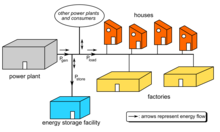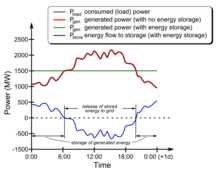
Back تخزين طاقة الشبكات Arabic Almacenamiento energético en red Spanish ذخیره انرژی شبکه Persian Sähkövarasto Finnish Stockage d'énergie de réseau French Skladištenje energije iz električne mreže Croatian Energieopslagtechniek Dutch Magazynowanie energii elektrycznej Polish Uskladnenie elektrickej energie Slovak Накопичення енергії в мережі Ukrainian


Grid energy storage (also called large-scale energy storage) is a collection of methods used for energy storage on a large scale within an electrical power grid. Electrical energy is stored during times when electricity is plentiful and inexpensive (especially from intermittent power sources such as renewable electricity from wind power, tidal power and solar power) or when demand is low, and later returned to the grid when demand is high, and electricity prices tend to be higher.
As of 2020[update], the largest form of grid energy storage is dammed hydroelectricity, with both conventional hydroelectric generation as well as pumped-storage hydroelectricity.[1][2]
Developments in battery storage have enabled commercially viable projects to store energy during peak production and release during peak demand, and for use when production unexpectedly falls giving time for slower responding resources to be brought online. Green hydrogen, which is generated from electrolysis of water via electricity generated by renewables or relatively lower carbon emission sources, is a more economical means of long-term renewable energy storage in terms of capital expenditures than pumped-storage hydroelectricity or batteries.[3][4]
Two alternatives to grid storage are the use of peaking power plants to fill in supply gaps and demand response to shift load to other times.
- ^ "Grid Energy Storage Technology Cost and Performance Assessment" (PDF). US Department of Energy. Retrieved 23 December 2021.
- ^ "Energy Storage Cost and Performance Database". US Department of Energy. Retrieved 23 December 2021.
- ^ Cite error: The named reference
Schrotenboerwas invoked but never defined (see the help page). - ^ Cite error: The named reference
Liptákwas invoked but never defined (see the help page).
© MMXXIII Rich X Search. We shall prevail. All rights reserved. Rich X Search